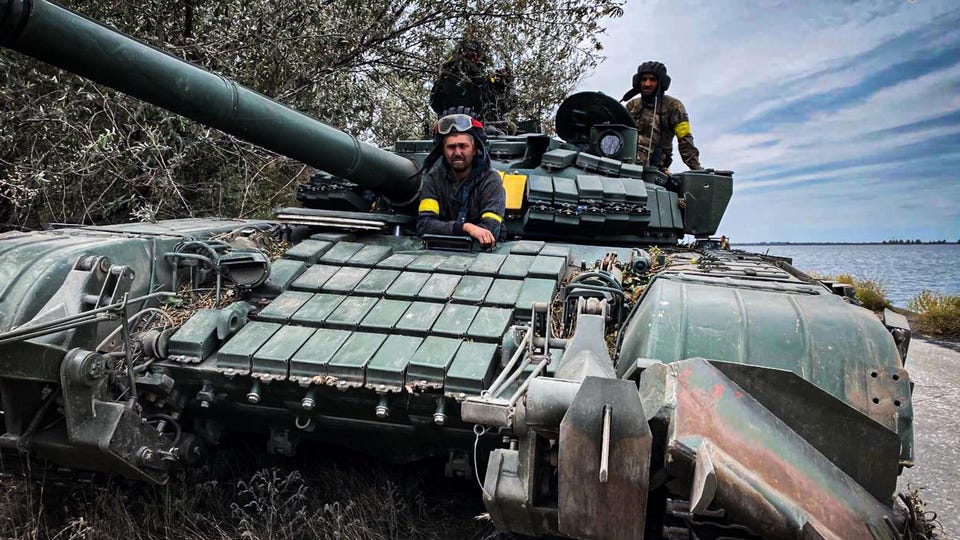In a cacophony of rocket barrages, drone strikes and anti-radar raids by fighter jets firing American-made missiles, Ukraine’s highly-anticipated southern counteroffensive finally kicked off on Aug. 29. A little more than a week later, Kyiv’s approach is becoming clearer.
It’s possible the Ukrainian army isn’t concentrating its roughly three-dozen battalions in the region—together overseeing perhaps 20,000 front-line troops—for a drive toward Russian-occupied Kherson, a strategic port with a pre-war population of 300,000. Rather, the Ukrainians might be aiming for the main Russian bridgehead across the Dnipro River, in Beryslav, 35 miles east of Kherson. That bridgehead, served by military pontoon ferries, crosses the two-mile river in order to feed ammunition, supplies and fresh troops to the 49th Combined Arms Army, whose three-dozen battalions represent the main Russian force in the south.
There once were other reliable routes into Kherson Oblast—bridges across the Dnipro in and around Kherson as well as a bridge spanning the Inhulets River northeast of the port city. But the Ukrainian batteries firing U. S.
-made, GPS-guided rockets in recent weeks damaged or dropped many of those bridges. “Cue the Russians beginning to run out of supplies, and being restricted to defensive ops that side of the river,” tweeted Mike Martin, a fellow at the Department of War Studies at King’s College London. If Ukrainian troops destroy the bridgehead in Beryslav, they could at least temporarily cut off the 49th CAA’s units from resupply, thus further reducing them and—in the best-case scenario for Kyiv—potentially inducing widespread retreat or surrender.
There already have been reports of successful Ukrainian artillery strikes in Beryslav. It’s possible the Beryslav gambit was just one of several options as Ukrainian forces attacked south from their own Inhulets bridgehead last week. There are credible reports of Ukrainian troops liberating villages all along the roughly 100-mile-long southern front.
“The Ukrainians [were] putting pressure on the Russian lines along the front,” Martin tweeted. “This enables them to probe and see where the Russians have weak spots. ” The Beryslav axis appears to be one of those weak spots.
“There are … indications [Russian] troops are falling back to the Beryslav bridgehead … as part of a ‘refit’ and ‘reconsolidate’ operation,” retired U. S. Army general Mark Hertling sarcastically tweeted .
“Once there, it’ll be hard for them to get back across the very wide river to escape. ” If the Ukrainian army in coming days or weeks can fight all the way to Beryslav and dislodge the Russian lodgement, potentially thousands of Russian troops in western Kherson Oblast will have few options for resupply, reinforcement, relief … or retreat. Russian air strikes targeting the settlements of Sukhy Stavok, Bezimenne and Kostromka could indicate Ukrainian forces have advanced 7.
5 miles southeast of their bridgehead around Davydid Briv, the Washington, D. C. Institute for the Study of War noted .
That’s a third of the way to Beryslav. But a direct Ukrainian assault on the Beryslav lodgement isn’t a foregone conclusion. Kyiv’s army might have intact supply lines, better morale and a lot of impressive American-made weaponry, but as far as infantry and tanks go, it doesn’t have a numerical advantage over the 49th CAA in Kherson Oblast.
The Beryslav bridgehead could become a tough objective as more Russian troops concentrate around it. Ukraine’s Southern Operational Command spokesperson Nataliya Gumenyuk claimed Ukrainian forces “have enough resources and forces to restrain Russian combat power in southern Ukraine,” according to ISW. But that could change if Ukrainian losses spike.
.
From: forbes
URL: https://www.forbes.com/sites/davidaxe/2022/09/06/russias-main-southern-bridgehead-could-be-ukraines-main-target/



